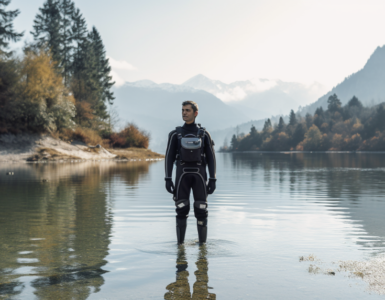When it comes to water sports, there’s a whole sea of choices out there. Over the years, both kneeboarding and wakeboarding have ridden the wave of popularity. But what sets these two thrilling sports apart? While both involve being towed by a boat and require balance, coordination, and a love for water, they offer different experiences and challenges. This article aims to make a splash by diving into a detailed comparison between kneeboarding and wakeboarding.
The Basics of Kneeboarding
What is kneeboarding, you ask? Originating in the 1950s, kneeboarding is a water sport where the rider kneels on a hydrodynamically shaped board while being towed by a boat. The rider holds onto a handle connected to the boat and uses their body weight and handle movement to control the board’s direction.
The equipment needed for kneeboarding is pretty straightforward. You need a kneeboard, a tow rope, and a personal flotation device (PFD) for safety. Kneeboards are designed with special features like padded decks and strap systems to provide stability and control while riding.
The Basics of Wakeboarding
On the other hand, wakeboarding is a slightly younger sport, tracing its roots back to the 1980s. Here, the rider stands on a short, wide board similar to a snowboard and is towed by a boat. The rider can ride the wake created by the boat, performing jumps and tricks in the process.
Wakeboarding equipment includes the wakeboard itself, a tow rope, a PFD, and often, bindings to secure the rider’s feet to the board. Wakeboards come in different shapes and sizes, with various features that affect the ride, such as fins for stability and different rocker shapes for maneuverability.
Understanding the Technicalities
As with any sport, mastering the technicalities is key to enjoying and excelling at it. But how do these technicalities differ between kneeboarding and wakeboarding? Let’s dive in and analyze.
Kneeboarding Technique
Ever wondered what makes kneeboarding unique? It’s all in the technique. The rider sits on their heels, with their knees bent and strapped to the board. Sounds simple, right? Well, maintaining balance, control, and maneuverability whilst in this position can be a thrilling challenge.
The rider uses a handle attached to a rope to pull themselves across the water. The key is to keep your body relaxed, your grip firm, and your eyes on the horizon. Sounds like a fun challenge, doesn’t it?
Wakeboarding Technique
Now, let’s move onto wakeboarding. Unlike kneeboarding, wakeboarding involves standing on a board while being pulled by a boat. The stance is similar to snowboarding or surfing, with your feet strapped onto the board and your body facing sideways.
Balance plays a crucial role in wakeboarding. It’s all about shifting your weight from one foot to the other to navigate across the water. Moreover, steering in wakeboarding is done primarily by edging, a technique that involves tilting the board to carve through the water. Sounds exciting, doesn’t it?
Equipment Comparison
Now that we’ve understood the techniques, let’s compare the equipment used in both sports.
Kneeboard Design and Features
The design of a kneeboard is quite distinctive. It is generally thicker and wider than a wakeboard, providing a stable platform for the rider. Furthermore, the kneeboard comes with a strap that secures the rider’s thighs to the board, allowing for better control and balance. The board’s surface is often padded, which provides extra cushioning for the knees.
Did you know that the shape of the kneeboard affects its performance? For instance, a sharper edge allows for quicker turns, while a rounded edge provides a smoother, more stable ride. Fascinating, isn’t it?
Wakeboard Design and Features
As for the wakeboard, it resembles a short, wide surfboard. Most wakeboards feature a pair of fixed, non-release bindings that secure the rider’s feet to the board. The board’s design, including its size, shape, and rocker (the curve of the board), significantly impact its performance.
For instance, a longer board provides greater stability and is ideal for beginners, while a shorter board offers more maneuverability and is preferred by advanced riders. Similarly, a board with more rocker is better for performing tricks, while a board with less rocker offers a faster, smoother ride. Isn’t it amazing how these little details can make such a big difference?
Skill Level Requirement
Ever wondered which one is easier to start with – kneeboarding or wakeboarding? Let’s break it down. Kneeboarding, due to its lower center of gravity and the rider’s kneeling position, is typically considered easier for beginners. The kneeling position gives a greater sense of control and balance, making it less intimidating for those new to water sports.
Wakeboarding, on the other hand, requires a bit more skill and balance as you are standing upright on the board. It may take a few tries to get the hang of it, but don’t let that discourage you. The thrill of mastering the wakeboard is truly unmatched!
Fitness and Health Benefits
Both kneeboarding and wakeboarding are excellent ways to stay fit, but they do target different muscle groups. When kneeboarding, the rider’s lower body, particularly the legs and core, get a solid workout. The act of balancing and controlling the board really engages these muscles.
Wakeboarding, due to the standing position, involves a full body workout. From your legs maintaining balance, your core stabilizing your body, to your arms holding onto the rope, it’s an effective and fun way to keep fit. Sounds like a win-win, doesn’t it?
Comparing Kneeboarding and Wakeboarding
| Kneeboarding | Wakeboarding | |
|---|---|---|
| Technique | Lower center of gravity, kneeling position, easier for beginners | Higher center of gravity, standing position, requires more skill and balance |
| Skill Level | Easier to learn | Takes more practice to master |
| Fitness Benefits | Works lower body and core | Full body workout |
| Excitement Factor | Great for beginners and offers a sense of control | Greater thrill once mastered, possibility of performing more tricks |
At the end of the day, both kneeboarding and wakeboarding have their unique appeal. If you’re new to water sports and looking for a place to start, kneeboarding might be the way to go. But if you’re up for a challenge and a full body workout, wakeboarding could be your new favorite hobby. Why not give both a go and discover your preference?
Safety Considerations
When it comes to water sports, safety should always be a top priority. Both kneeboarding and wakeboarding, like any other sport, come with their own set of risks. But what are these risks, and how can we mitigate them?
Wakeboarding, due to its more upright stance and high-speed nature, might pose a higher risk of injury. Falls can result in sprains, strains or even concussions. Therefore, wearing a helmet and proper protective gear is highly recommended.
Kneeboarding, on the other hand, is perceived as less risky due to the lower center of gravity. However, it’s still crucial to use appropriate safety equipment such as a buoyancy aid and helmet. Remember, safety first!
The Excitement Factor
Let’s face it, we’re all looking for a bit of thrill when we venture into water sports, right? But which one between kneeboarding and wakeboarding offers more excitement?
Many consider wakeboarding to be more thrilling due to the possibility of performing more complex tricks and jumps. The speed and the upright position add to the adrenaline rush.
However, don’t underestimate the fun factor in kneeboarding. The feeling of skimming the water surface at high speed while kneeling can be exhilarating. Plus, it’s a great way to build confidence before moving onto more challenging water sports.
Making the Choice
So how do you decide between kneeboarding and wakeboarding? Here are some key points to consider:
- Assess your fitness level and skill: Wakeboarding requires a bit more strength and balance while kneeboarding is a great starting point for beginners.
- Consider the thrill factor: If you’re looking for high-speed action and the opportunity to perform tricks, wakeboarding might be more up your alley.
- Think about safety: Are you comfortable with the potential risks associated with each sport? Remember, safety should always come first.
- Try both: Why not give both a shot and see which one you enjoy more? After all, variety is the spice of life!
Final Thoughts
And there you have it – a comprehensive comparison between kneeboarding and wakeboarding. Both sports offer a unique experience and have their own set of advantages and challenges. It all boils down to personal preference, fitness level, and thrill-seeking appetite.
Whether you choose to ride the waves on your knees or standing up, the most important thing is to enjoy the ride and stay safe. So, are you ready to make a splash?




